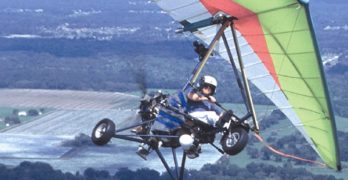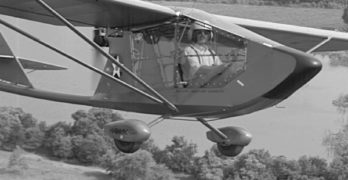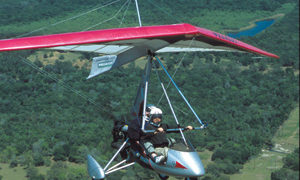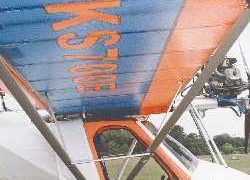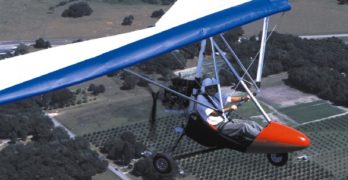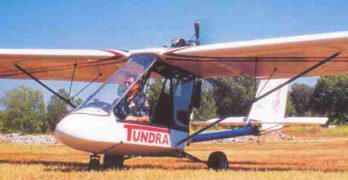Until recently, we heard little from South Africa. Under the country’s apartheid (racial segregation) rule of the past, South Africa disappeared off the radar so far as most Yankee pilots knew. Our government instituted economic sanctions so that few, if any, South African products appeared in America.
Apartheid is over, and with it the isolation of that southern hemisphere country and its people. In recent years, we’ve seen a growing number of products arrive from the way down under country. Perhaps you’re not surprised to hear that South African ultralight builders are also making a mark on American aviation. Welcome to the modern age of globalization.
No Pushy Peddler
You probably already know of Rob Rollison. He garnered attention in April ’95 by flying his Air-Bike from Indiana to Lakeland, Florida.1 The trip set no records – Ian Coristine, Dave Goulet and Don Zank flew 2-seat Challengers 2,400 miles (round trip) from Moline, Illinois to Lakeland a decade earlier – but in an open-cockpit ultralight, no doubt Rob’s 870-mile (each way) flight seemed longer.
Search Results for : four-stroke
Not finding exactly what you expected? Try our advanced search option.
Select a manufacturer to go straight to all our content about that manufacturer.
Select an aircraft model to go straight to all our content about that model.
Hawk Plus
CGS’ new Hawk Plus
As the year 2000 approaches, computer programmers may be sweating that Y2K bug we’ve all heard way too much about. Ultralight enthusiasts, on the other hand, will be celebrating the completion of two full decades as a member of the aviation community. Throughout the 1980s and 1990s, a lot has happened.
This newest community of pilots and designers learned a great deal. Accidents are far lower than in the “old” days, and equipment is far better. Specifically, ultralight aircraft designs are the best we’ve seen, with many reliable brands offering airworthy sport-flying machines.
Buyers of ultralights include those lightweight enthusiasts who enjoy Part 103’s freedom from FAA licenses, registration or certification. That’s why ultralights can be bought for $10,000 to $15,000, and you don’t need an FAA ticket to fly one legally. That fact practically assures that ultralights will stay on the radar of many aging baby-boomer pilots.
Flex-Wing or Fixed Wing
This month I wrote a pilot’s report about two widely different aircraft, both of which are imported by Rollison Airplane Company. Here’s how I handled it.
Every “Ultralight Flying! Pilot’s Report” has common elements: a main article, photos and photo legends, specifications, and our exclusive “Report Card.” Because the two subject flying machines are so different this month, I’ve prepared a “Report Card” for each aircraft. I did the same for specifications as the standard and optional features obviously differ too much for grouping.
In the main article, I take alternate looks at the two flying machines as a way to observe their differences, but further how they each have their benefits.
I also selected more photos – even though Ultralight Flying! reports regularly present many photos of ultralights being reviewed as readers often say that photos are a key informative element.
Because reviewing two different craft makes for a longer pilot report, I’ve somewhat abbreviated both the main article and the twin “Report Cards.”
Quite a few general aviation pilots recognize that ultralights offer a different way to fly| and that’s precisely what they like about them.
Titan Tornado
An Experimental ‘fighter jet’ that any pilot could love That vast majority of general aviation pilots who won’t even think about building their own plane has missed quite a revolution.
The FAA says approximately 25,000 aircraft are registered as Experimentals. That’s 15% of the GA fleet.
Building isn’t what it used to be. You no longer need to master the skill of reading engineering prints (plans), nor must you search high and low for parts.
These days, most registered Experimental aircraft are built from kits. Many are well-fabricated packages that can be assembled in just a few hundred hours. That can mean as little as two or three hours a night, two to three days a week, for about a half-year. Not a bad investment for a truly unique airplane.
One sport pilot who enjoys flying his creations is Minnesota resident Al Reay. For Reay, building is a means to an end.
Super Magnum
The Super Magnum packs an 80-horse four-stroke Verner Some general aviation pilots are put off by ultralights; for others they’re great fun.
If you’re the type who likes the idea of ultralight flight but you don’t trust the common two-stroke engines, then Sport Flight’s Super Magnum kit-built aircraft with the Verner engine may be what you’re looking for.
JOIN THE FAMILY
For nearly a decade, Sport Flight Aviation has produced the Talon XP two-seater and the Magnum single-seater. In 1998 the company added the Super Magnum, a one-place airplane that features a substantial 80-horsepower engine from the Czech Republic.
The Verner SVS-1400 engine was brought to the United States by Milan Stavenik in the mid-1990s. Milan lost his life in an accident unrelated to the Verner, but development of the engine has continued under Sport Flight Aviation owner Roger Bitton.
In addition to the Verner, the new HKS 700E, imported from Japan by Hpower, is enjoying a good reception.
2000 HKS
The 2000 HKS
In a concerted effort to give Rotax a challenge in the U.S. (and the world), the 60-hp 4-stroke HKS 700E engine arrived in America during 1998. Oh, sure, other engine makers including Hirth, Zenoah, and 2si have been in the market longer but they haven’t made a significant dent in the dominance enjoyed by Rotax.
To be honest, neither has the HKS… yet. Any brand-new engine is bound to have teething pains – even from a company that is a well-established purveyor of engine products in the auto industry. Some of the first 100 HKS engines to arrive in the U.S. experienced various minor troubles.
To the enormous credit of HKS and their American partner, HPower Ltd., all those HKS buyers received the same customer service care that Flightstar buyers have long appreciated. In some cases new parts were sent without charge and in all cases, HKS buyers could count on concerned attention from HPower.
The Appeal of Trikes
Trikes: they’re enjoyed around the world by thousands of pilots A what?
Not sure what a “trike” is, are you? Don’t feel bad. Although these machines may represent the largest production of aircraft in the world, many pilots have overlooked their appeal.
A trike is an aircraft made of two principle parts: a wing that resembles a hang glider (but is more stoutly built) and a carriage. The latter element is comprised of an engine, landing gear, seat and instrumentation. Within certain bounds, the wings and carriage can be mixed and matched.
They may sound strange, but they are enjoyed around the world by thousands of pilots. In fact, among European light aviation enthusiasts, about one in every two flies a trike.
Just a toy? Not!
In case you think that such a contraption must be only for young sport enthusiasts that don’t have enough money for a “real” airplane, think again.
Joplin Light Aircraft — Tundra
The Tundra evolved out of experience with the old Beaver 650 that had loads of development but which never really got squarely on the market. Thanks to its resurrection by Laron a few years back, this desirable aircraft flies onward.
Today, the model is built by Joplin Light Aircraft who bought the design rights for the Tundra and 1/2-Tun (single seater). Joplin got started distributing ASAP products in the U.S. but has now grown into an Original Equipment Manufacturer to better implement their own improvement ideas.
One of these upgrades involves the impressive Geo-Suzuki engine. This 65-horse four stroke powerplant burns a mere 2 gph from its smooth-running three cylinders. Best of all the lively engine is priced at $4,995, well below that of some four-stroke options available to ultralight enthusiasts. Joplin makes the Tundra available standard with a Geo-Suzuki conversion, so adding the engine is simpler.
A tandem design, the Tundra is easily appreciated by larger American pilot because it enjoys a wide cabin with ample elbow room.
Rotax’s new 912S
Rotax’s new 912S produces more horses per dollar than its 80-hp 912 (no “S”). One of the big success stories in light aviation powerplants is the Rotax 912. The four-stroke engine evolved from Rotax’s two-stroke line and offered a strong 80 horses. Still, some planes need a little more.
MORE GET UP AND GO
“An airplane that climbs well on the (regular) 912 won’t see much improvement from the 912S,” said one of the leading importers, Phil Lockwood of Lockwood Aviation Supply.
“But if your plane climbs a bit marginally with the 912, the 25% power increase in the 912S will make a world of difference.”
More power usually means more weight; however, the 912S adds a mere 3.5 pounds over the standard 912.
Rotax Aircraft Engines – a division of world aviation leader Bombardier – also offers the 914, a turbocharged version of the 912. The 914 brought power from 80 horses to 115 (with 100 continuous), but comes with a substantial price increase.
Dakota Hawk
Vintage looks. A few companies in aviation specialize in the look and feel of aircraft from yesteryear. These manufacturers offer aircraft that are reminiscent of days gone by in aviation. Visually and even in the way they fly, these machines can transport enthusiasts back to the so-called Golden Era when the nascent aviation industry offered simple, easy to fly aircraft like the Piper Cub and others. Today, most of these specialty aircraft are kit-built airplanes because the freedom of the Experimental 51% rule permits exploration that cannot be justified when making a fully FAA certified model. Some of these kit manufacturers hail from the ultralight community. Fisher Flying Products is one such company.
Second-Generation Fisher
In two ways, North Dakota-based Fisher Flying Products is a second generation company. First, the company now owned by Darlene Jackson and husband Gene Hanson was purchased from Mike Fisher, who subsequently started another business using his name.


